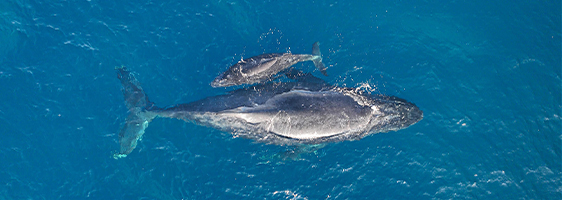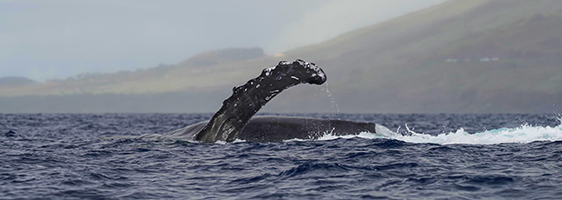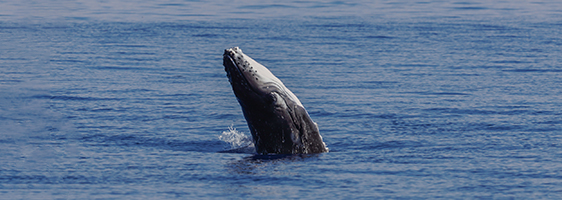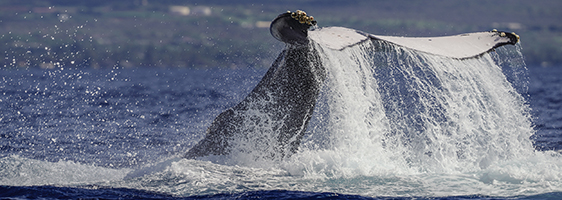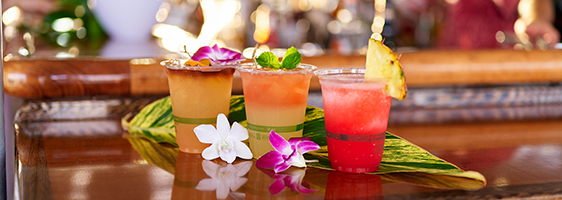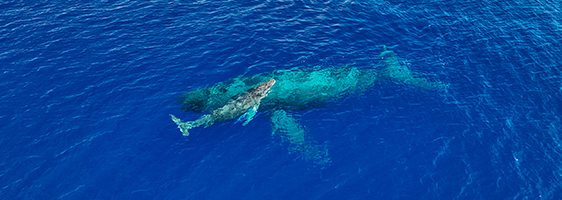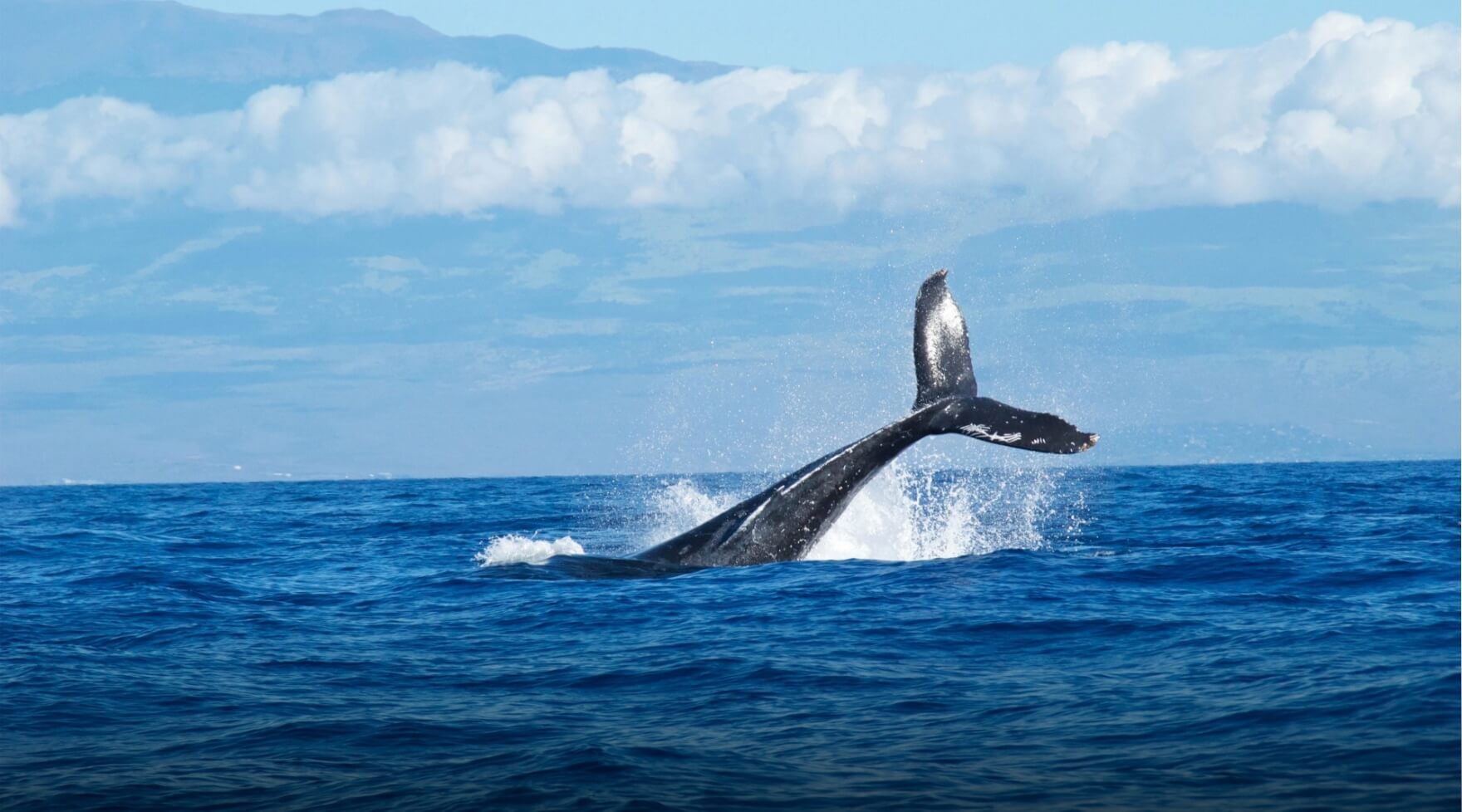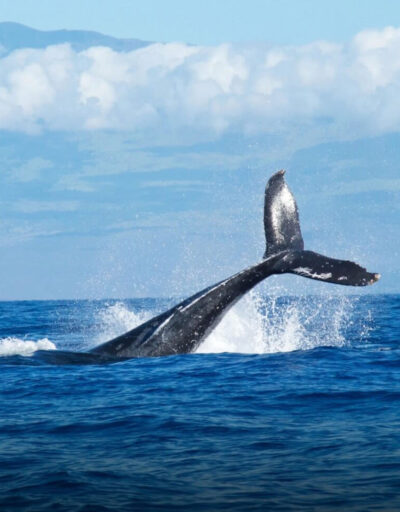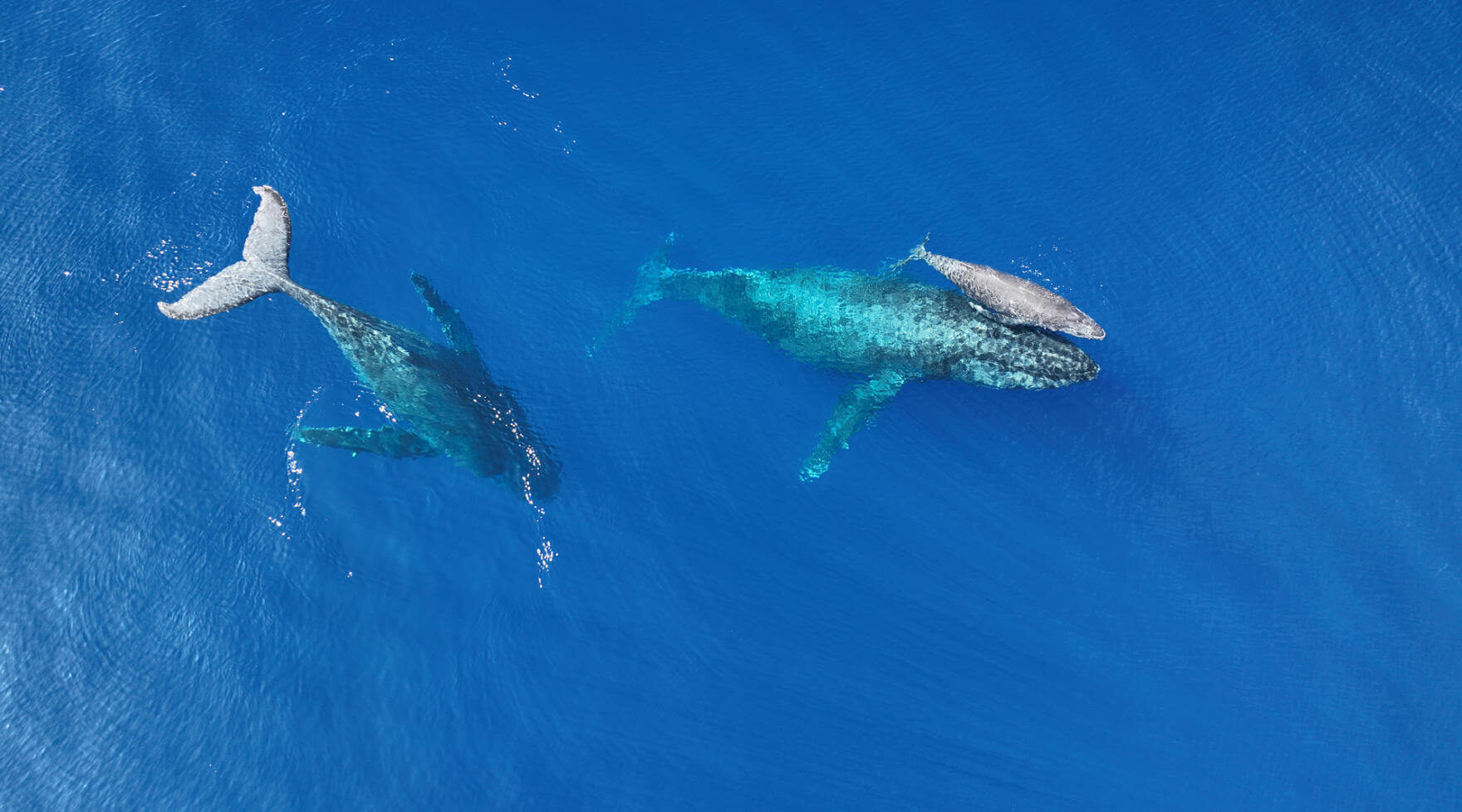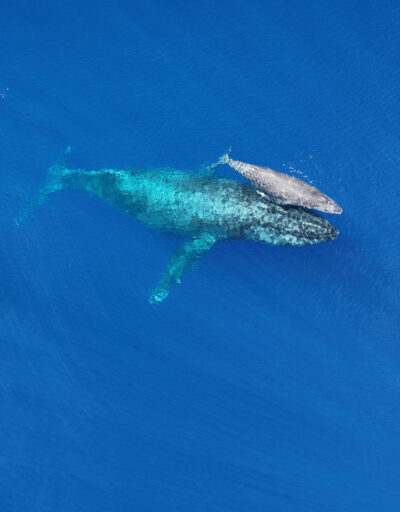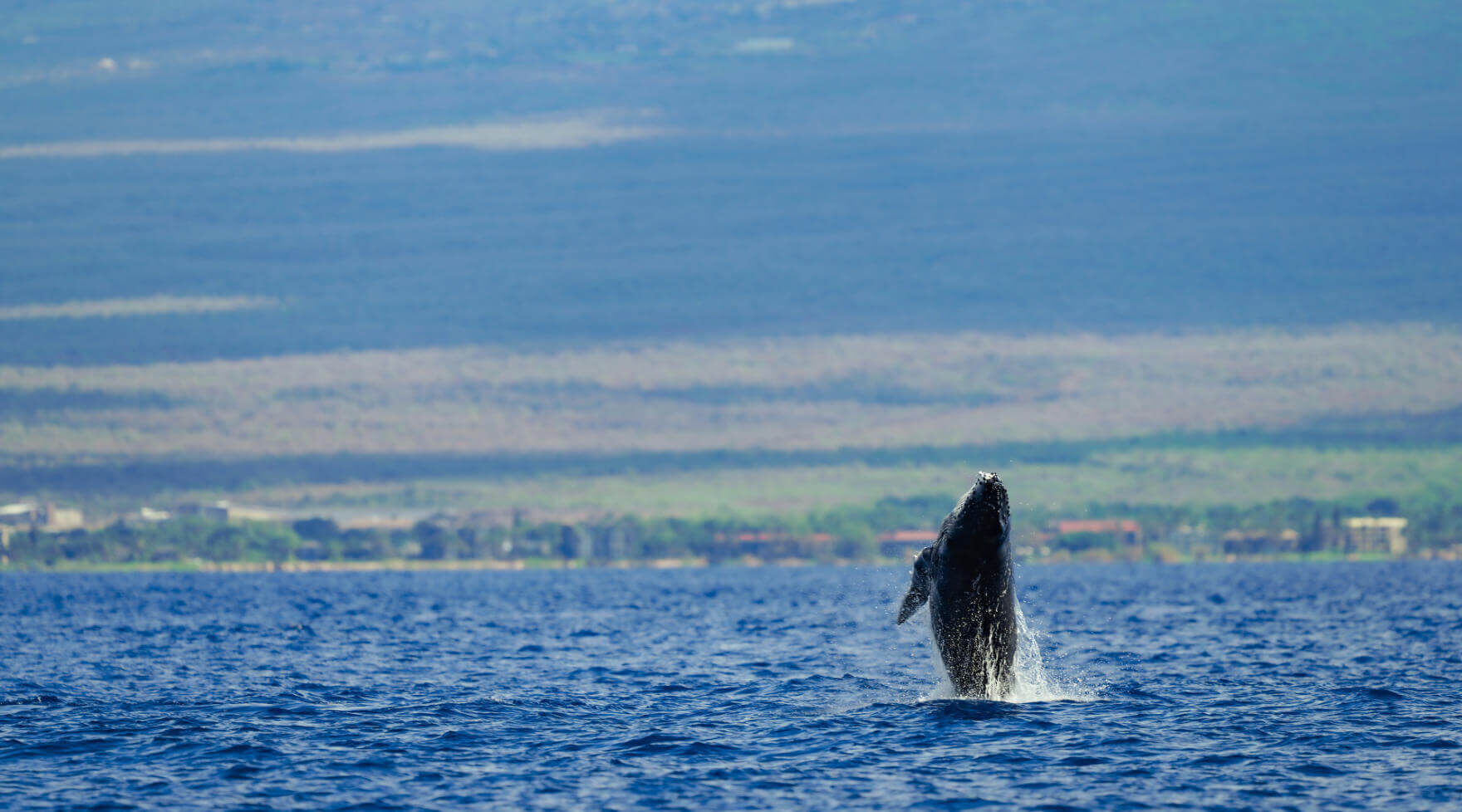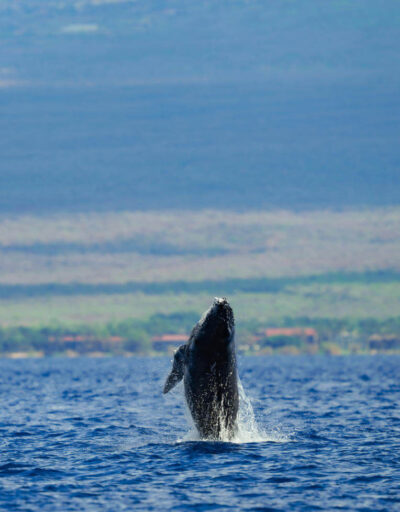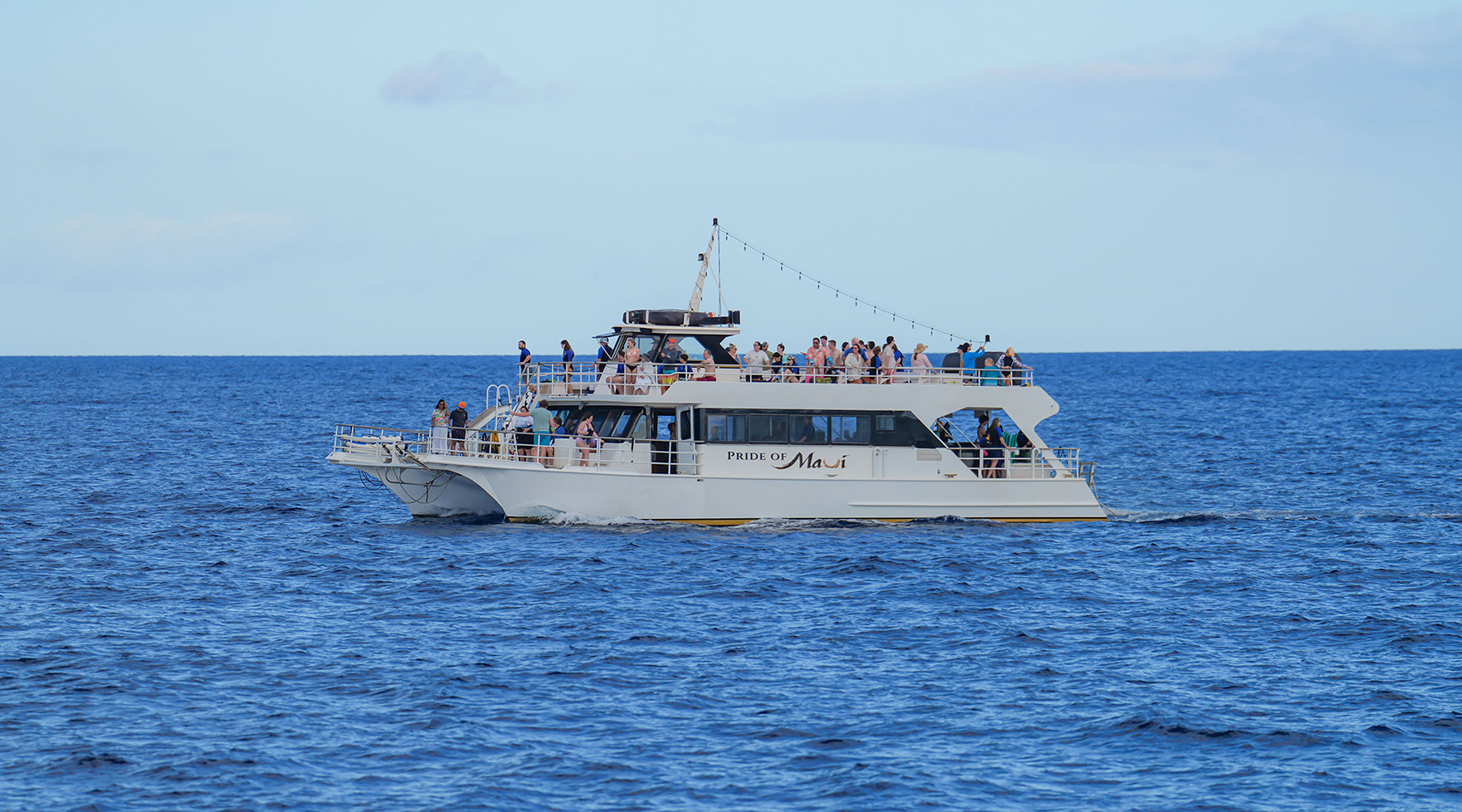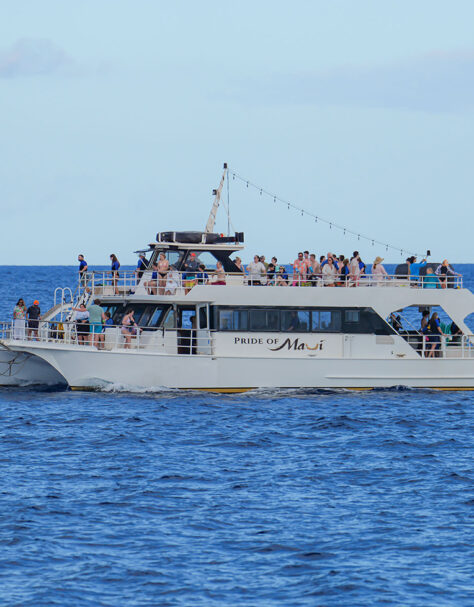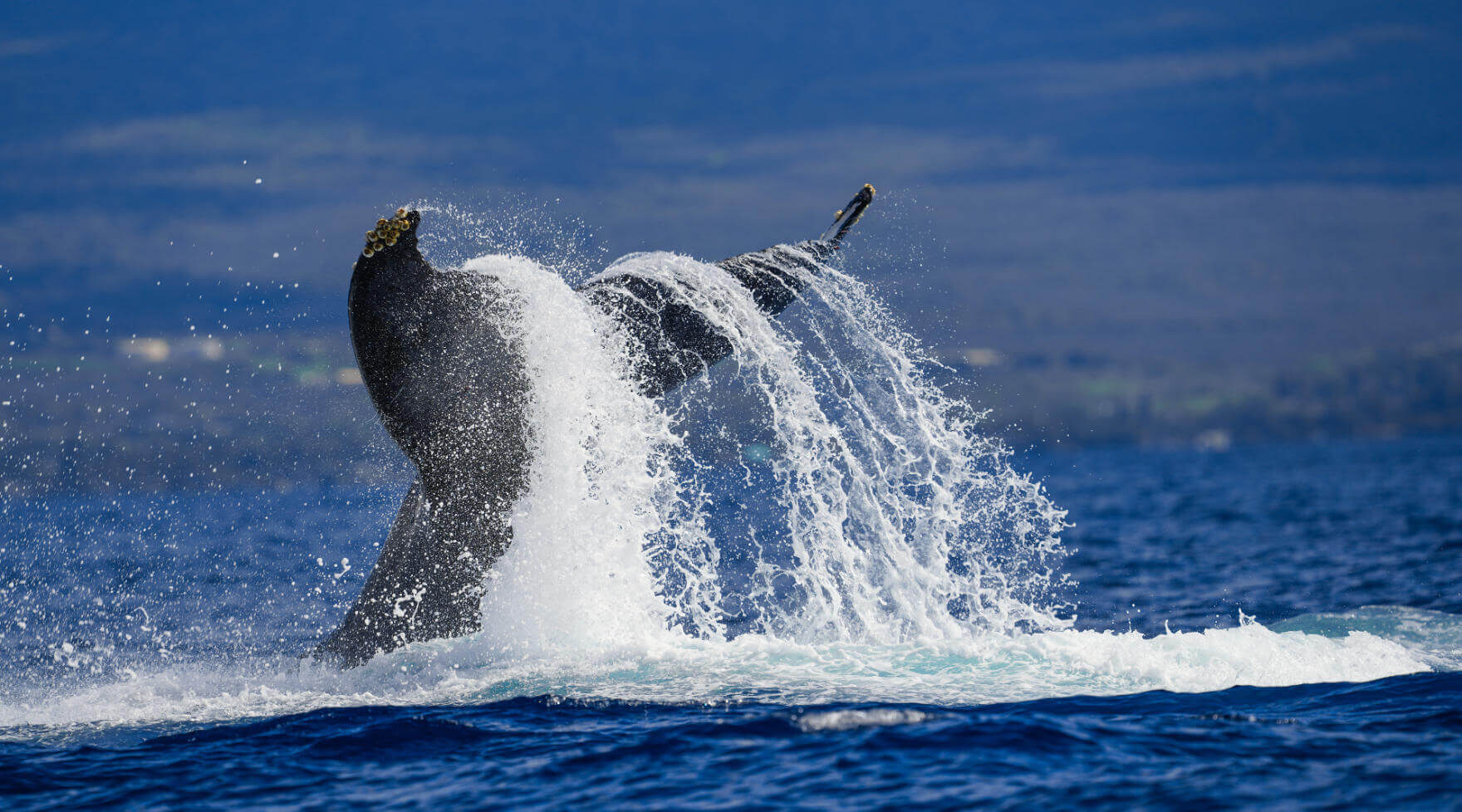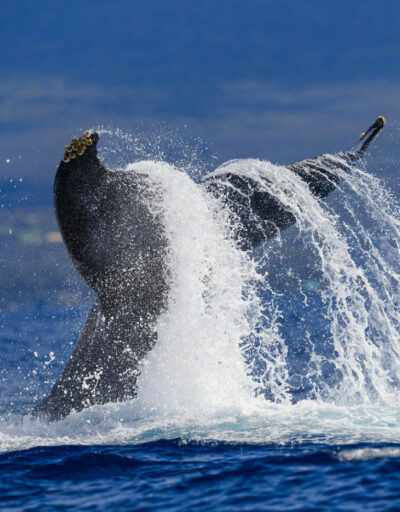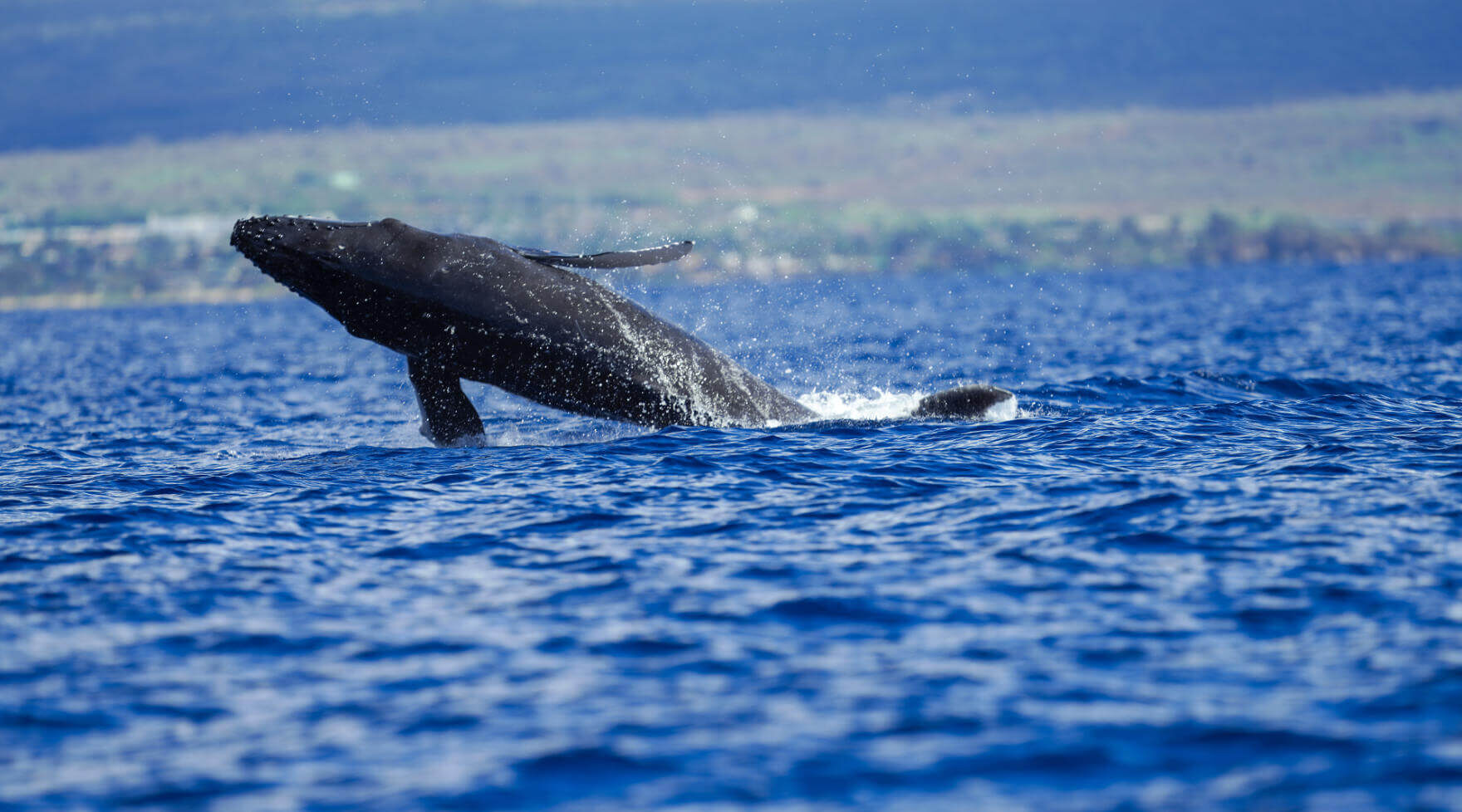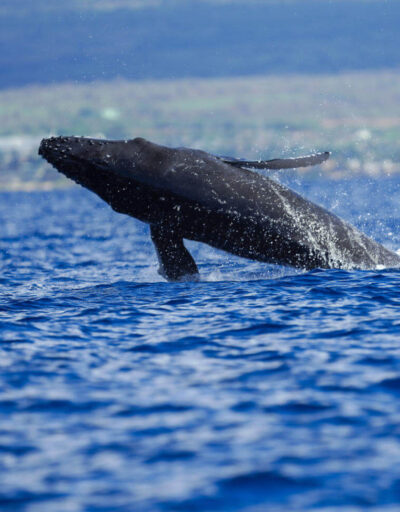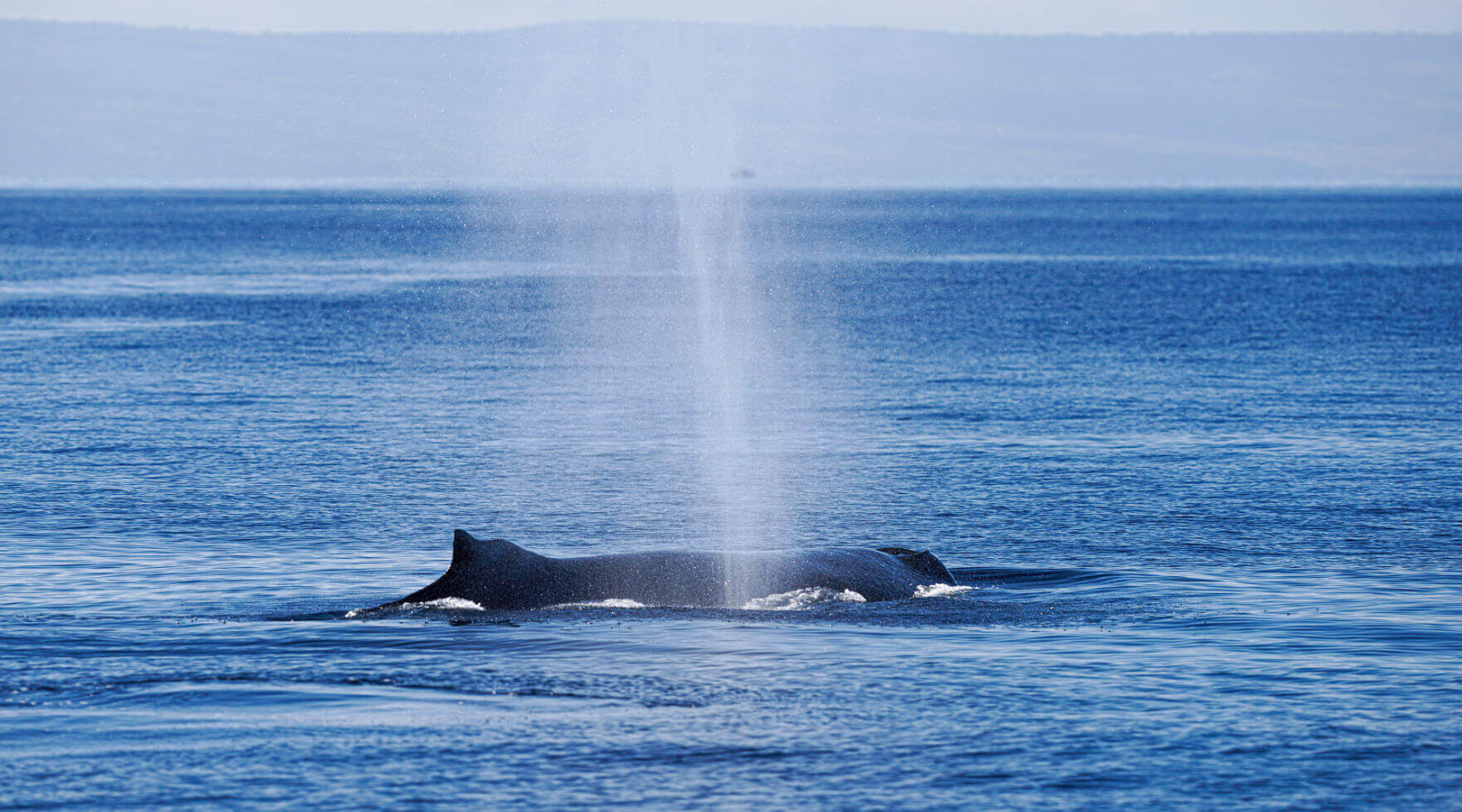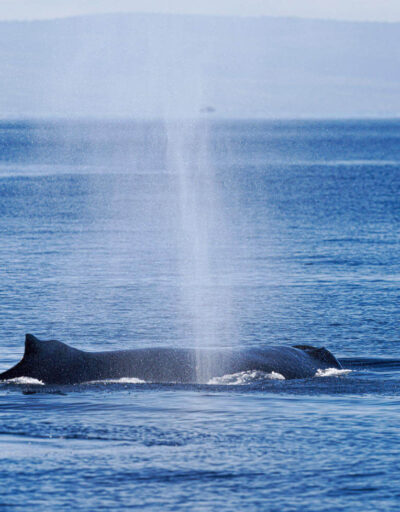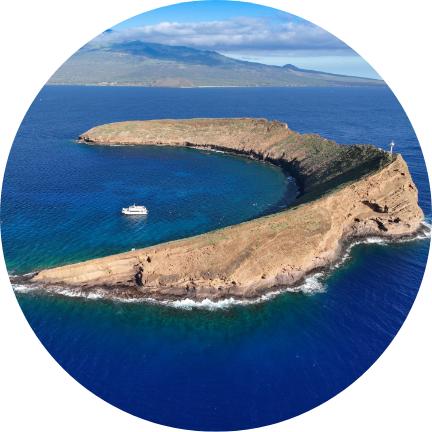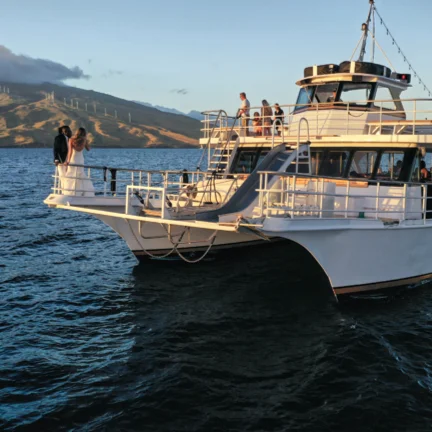Maui Whale
 Watching
Watching

Book Maui Whale Watching
13+$104$94Children
4-12FREEFREEInfants
Whale watching on Maui
Whale watching on Maui offers a rare chance to witness North Pacific humpback whales during their annual migration to Hawaiʻi’s warm, shallow waters. From the deck of the Pride of Maui, guests may see breaching, tail slaps, pectoral fin waves, and hear the resonant sounds of whale song. Our crew shares insights into whale behavior, Hawaiʻi’s marine ecosystem, and the islands’ role as a vital calving and nursing habitat.
This seasonal tour also includes a captain-selected snorkel stop, giving guests the chance to enjoy Maui’s reefs after whale watching. All equipment is sanitized between uses.
Highlights
- Peak-season whale watching: guided viewing of humpback behaviors January through March
- Narrated experience: learn about migration patterns, behaviors, and Maui’s marine environment
- Snorkel stop: snorkeling site chosen by the captain
- Gear included: sanitized masks, snorkels, and fins (adult and child sizes)
- Comforts on board: restrooms, warm showers, shaded seating, indoor cabin, freshwater rinse
- Food and drinks: breakfast, BBQ lunch, juices, sodas, water
- Crew and safety: trained lifeguards, ocean-safety briefing, reef-safe sunscreen only, no disturbing wildlife
- Peak-season whale watching: Guided viewing of humpback whale behaviors along Maui’s coastline, following NOAA’s respectful wildlife guidelines
- Snorkel stop: Captain-selected site for safe conditions and clear visibility. Sanitized snorkel gear and flotation provided for all ages.
- BBQ lunch & beverages: Hot BBQ lunch served after snorkeling, plus juices, sodas, and filtered water. Premium bar opens once all water activities are complete.
- Comfortable onboard amenities: Spacious decks, shaded seating, indoor cabin, warm showers, restrooms, submerged ladders, and easy water access.
- Safety-first crew: Lifeguard-trained team, clear snorkel briefings, and dedicated guest support throughout the tour.
- Reef-safe sunscreen: Required to help protect Maui’s reefs and marine life.
From our Mā‘alaea Harbor, North Dock slip, we set out on a 3.5-hour whale watching and snorkeling adventure. The captain navigates Maui’s coastline to the best locations for viewing humpback whales, while the crew shares insights into their behaviors and seasonal migration.
- Boarding & briefing — 1:30 pm. Meet the crew, collect snorkel gear, and receive a short ocean-safety orientation.
- Whale watching — 2:00 pm. Watch for breaches, tail slaps, pectoral waves, and mother-calf pairs during Maui’s peak whale season.
- Snorkel stop. After whale watching, enjoy snorkeling at a captain-selected site chosen for visibility and safe conditions.
- BBQ lunch onboard. Lunch is served after snorkeling as we cruise back toward Mā‘alaea Harbor.
Return time is approximately 5:30 pm.
- Reef-safe sunscreen (required)
- Towel and dry clothes
- Swimwear worn under clothing
- Sunglasses and a light jacket
- Waterproof phone case (optional)
- Motion-comfort remedies if needed
Lunch
After snorkeling, enjoy a freshly prepared BBQ lunch featuring big juicy burgers, jumbo hot dogs, cheese and crackers, potato chips, fresh fruit, and ginger shoyu chicken. Save room for our homemade macadamia-nut white-chocolate chip cookies, baked fresh.
Vegetarian & Vegan Options
Plant-based or vegan meals are available with 72-hour advance notice. Call Guest Services at 808-242-0955 to request accommodations.
Premium Open Bar
Our premium bar opens after all water activities and includes local craft beer, citrus-forward Sauvignon Blanc, crisp Chardonnay, and our signature Mai Tais. Non-alcoholic beverages include juice, filtered water, and sodas.
Board at Mā‘alaea Harbor, North Dock (left of USCG).
Look for the Pride of Maui vessel and uniformed crew. Parking is available near the harbor; please allow extra time during peak season.
For additional details, visit our Maps & Directions page.
- Reef-safe sunscreen only to protect coral and marine life
- No touching or disturbing whales, turtles, or any marine animals
- Follow crew instructions when entering and exiting the water
- Trained lifeguards provide in-water support
- Whale watching follows NOAA viewing guidelines for safe, respectful distances
Please read our list of snorkeling safety tips.
Maui Whale Watching & Snorkel Tour
Maui’s best
whale watch
value
Exceptional Whale Watching Value
Experience Maui in winter at its most unforgettable. Enjoy two full hours of whale watching during peak season, followed by a snorkel stop chosen by the captain based on the day’s safest, clearest conditions.
Pride of Maui is one of the island’s most stable and spacious catamarans. The vessel includes two restrooms, warm freshwater showers, submerged ladders, shaded seating, an indoor cabin, a water slide, a large hardwood bar, and over 2,500 square feet of open deck space for panoramic viewing.
Whale Watching on Maui
From December through March, North Pacific humpback whales gather in the warm, shallow waters surrounding Maui. This region hosts one of the highest seasonal concentrations of humpbacks in the world. Guests may witness breaching, tail-lobbing, pectoral slaps, spy-hopping, escort pairs, and curious calves practicing beside their mothers.
During peak season, sightings are frequent and often spectacular. Our captain and crew position the vessel responsibly to provide excellent viewing opportunities while following all federal whale protection guidelines.
December 1st – March 31st
Maui
whale
season
For more than one reason, the Island of Maui is consistently rated among the best places in the world to visit—something both locals and humpback whales seem to agree upon. Each winter, these remarkable mammals journey from cold Alaskan waters to Hawaiʻi’s warm, protected ocean for their annual breeding season.
Early arrivals may appear as soon as October, and numbers steadily grow through the holidays as more pods and escorts reach Maui. Whale Season spans from mid-fall to April, with peak viewing typically from January through March.
Humpback Whales
What
you’ll see
Common Behaviors
Guests may observe blowing, spy-hopping, fin and tail slaps, competition among males, escort pairs, and playful calves learning beside their mothers. Mature humpbacks reach about 40 ft and average 40 tons, though some grow larger; newborn calves weigh roughly 1–1.5 tons and reach up to 14 ft in length.
Restrictions
Data from NOAA, Hawaiʻi DLNR, and the Hawaiian Islands Humpback Whale National Marine Sanctuary outline strict federal protections for all North Pacific humpback whales. These baleen whales are classified as a protected species. Approaching them within 100 yards is prohibited, and Pride of Maui strictly follows these regulations.
Curious whales may sometimes approach vessels on their own. These moments offer exceptional viewing, but the vessel remains stationary to ensure compliance and safety.
Maui Whale Watching & Snorkeling
Maui
Snorkeling
Snorkeling on a whale watching tour gives guests a fun, relaxing break between viewing periods. While whale watching is the primary focus of the day, our snorkel stop offers a chance to see Maui’s colorful reef fish, corals, and vibrant underwater scenery.
Snorkeling in Maui
Warm, clear conditions support an incredible diversity of tropical marine life. Guests may see Moorish idols, butterflyfish, angelfish, wrasse, triggerfish, and more. Snorkeling is suitable for beginners, and sanitized gear is provided.
Whale Watch Tour
Why
choose us?
Whale Sightings Guarantee
Whale activity increases through mid-January, with the most consistent sightings from January through March. If no whales are seen during your whale watching tour, we offer a complimentary return pass for a future whale watch.
This guarantee applies to whale watching tours between January and March only. Sightings in December and April vary with migration timing.
Snorkel Gear
We provide all sanitized snorkel gear needed for a comfortable experience, with optional wetsuits available for rent.
Amenities
Pride of Maui’s wide, stable platform offers ample viewing space and unobstructed photo angles. Amenities include a hardwood bar, warm showers, submerged ladders for easy entry and exit, restrooms, commercial BBQ grills, and a water slide for added fun after snorkeling.
Crew & Safety
Safety is our highest priority. Our captains and crew are trained in CPR, emergency response, and in-water support. Lifeguards are posted in the water and onboard during snorkeling. Pride of Maui operations follow modern navigation and safety standards so guests can relax and enjoy the experience.
Interesting Facts
About
Humpback
Whales in
Hawaii
Biology
North Pacific humpback whales generally range from 25–40 tons and can reach 60 ft in length. Calves are born at roughly 12–14 ft and gain weight rapidly on nutrient-rich milk. Adult humpbacks feed in Alaskan waters and rely on stored energy during their stay in Hawaiʻi.
Behavior
Humpbacks are known for expressive surface behaviors. Competitive pods of males may display head-slapping, tail-slapping, and breaching while vying for a female’s attention. Females with calves may seek sheltered areas where newborns can nurse and rest.
Conservation
Federal protections enacted through the Endangered Species Conservation Act of 1969 and the Marine Mammal Protection Act safeguard humpbacks from harassment and hunting. Tour operators in Hawaiʻi—including Pride of Maui—uphold strict viewing guidelines to protect these remarkable animals.
Migration
Humpbacks migrate roughly 3,500 miles from Alaska to Hawaiʻi, a journey that takes several weeks. They begin arriving as early as October, with peak numbers in winter, and depart gradually through April. Maui’s shallow, warm waters create ideal conditions for calving and social behavior.
Mating
Humpback mating is not directly observed in Hawaiʻi, but male displays during the season suggest active competition. Genetic studies show that calves from a single female often have different fathers across years.
Complimentary Lunch & Open Bar
Freshly
prepared
BBQ lunch
Lunch
Your freshly grilled BBQ lunch features cheese and crackers, big juicy burgers, jumbo hot dogs, potato chips, a fresh fruit platter, and ginger shoyu chicken. Save room for our homemade macadamia white-chocolate chip cookies, baked daily.
If your party includes vegetarian or vegan guests, please contact us at least 72 hours in advance at 808-242-0955.
Premium Open Bar
After snorkeling, enjoy an ice-cold selection from our Premium Open Bar, including Maui Brewing Company craft beer, crisp Sauvignon Blanc from Marlborough, premium Napa Chardonnay, and our signature Mai Tais. Non-alcoholic drinks include fruit juice, filtered water, and soda.
Whales
Migrate to
Maui’s Waters
Every Winter
Maui’s inviting, shallow coastal waters offer one of the most important seasonal habitats for North Pacific humpback whales. Each year, pods travel thousands of miles from Alaska to give birth, raise calves, and engage in mating competition within these warmer channels.
Migration begins as early as October and continues through early spring, with peak whale watching typically January through March.
Quick Facts
- Maui is consistently rated one of the world’s best islands to visit
- North Pacific Humpbacks migrate from Alaska to Hawaiʻi each year
- Whales use Hawaiʻi’s warm waters for birthing and social behavior
- Pods begin arriving around October and increase through winter
- Peak whale season runs January through March
FAQ
Maui’s whale season generally runs from late November through April, with peak viewing from January through March. During these months, thousands of North Pacific humpback whales migrate to the warm, shallow waters of the Maui Nui Basin for calving, nursing, and breeding. Sightings outside peak season are possible but less frequent.
Watch our short film about the humpbacks’ journey in the Pride of Maui blog.: Humpback Whale Migration to Maui
All operators must follow NOAA’s whale-protection guidelines, which require maintaining a 100-yard distance. Whales sometimes choose to approach vessels on their own. If this happens, we remain stationary to ensure a respectful and memorable viewing experience.
The NOAA’s Endangered Species Act protects Maui’s humpback whales, requiring all vessels to maintain a safe distance of at least 100 yards. However, whales are naturally curious and sometimes choose to approach boats. While we always maintain legal and respectful distances, these incredible creatures may occasionally provide thrilling close encounters on their own terms.
A significant portion (about two hours) of this 3.5-hour tour focuses on whale watching along Maui’s coastline. After viewing the whales, the captain selects a snorkel site for guests who want to explore the reef.
Yes. Our vessel is wide, stable, and designed for a smooth ride. Safety briefings are provided before departure, and our crew follows Coast Guard standards and NOAA whale-viewing regulations. Children must be supervised at all times, and infants are welcome on board.
Whale sightings are guaranteed January through March. If no whales are seen during these peak-season months, guests receive a free pass for another whale watch. Early- and late-season sightings vary with migration patterns, so the guarantee does not apply in December or April.
Humpbacks migrate over 3,500 miles from Alaska to Hawaiʻi to give birth, nurse their calves, mate, and rest in warm, protected waters. Maui’s shallow channels create ideal conditions for these seasonal behaviors.
Common behaviors include breaching, tail slaps, pectoral slaps, spy-hopping, and escorting. Mothers with calves often display gentle surface activity as newborns learn coordination and breathing patterns. Competitive groups of males may show more energetic displays during peak season. Guests may also be able to hear the whale songs aboard a Maui Whale Watching tour onboard the Pride of Maui.
Snorkeling is a secondary part of this whale watching tour. After the whale-watching portion, the captain chooses a snorkel location with the best visibility and safety conditions available that day. Snorkel gear and flotation are provided, and wetsuits are available to rent.
Guests may see butterflyfish, Moorish idols, angelfish, triggerfish, wrasse, and other tropical species. Visibility varies with conditions. Snorkeling is beginner-friendly, and our crew provides guidance as needed.
No. Guests may remain on board during the snorkel stop. Those who prefer to stay dry can continue enjoying the scenery, whale sightings, or a drink from the bar once water activities are complete.
Bring reef-safe sunscreen, a towel, sunglasses, a light jacket, swimwear worn under clothing, and any personal items you may need. All snorkel gear is provided. Cameras and phones should be waterproofed if taken near the water.
Boarding is via a stable harbor ramp at Māʻalaea. Wheelchairs and walkers are welcome on board, and the crew can assist with embarkation. Entering the water requires independent mobility, so please contact us before booking if you have specific accessibility questions.
Yes. Enjoy a freshly grilled BBQ lunch after snorkeling, plus non-alcoholic beverages throughout the trip. The premium open bar opens only after water activities, serving craft beer, wine, and our signature Mai Tais. Vegetarian or vegan meals are available with 72-hour advance notice.
Snorkel & Explore Molokini Crater near Maui
Book
online
Pride of Maui
Create Maui vacation memories that will last a lifetime!
Book Now



 Watching
Watching